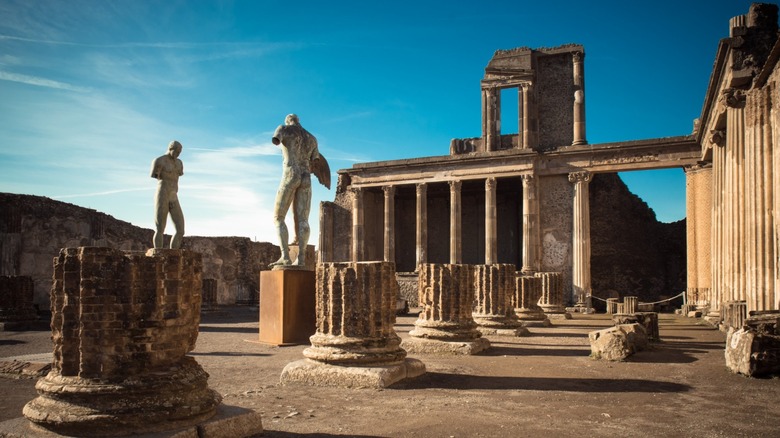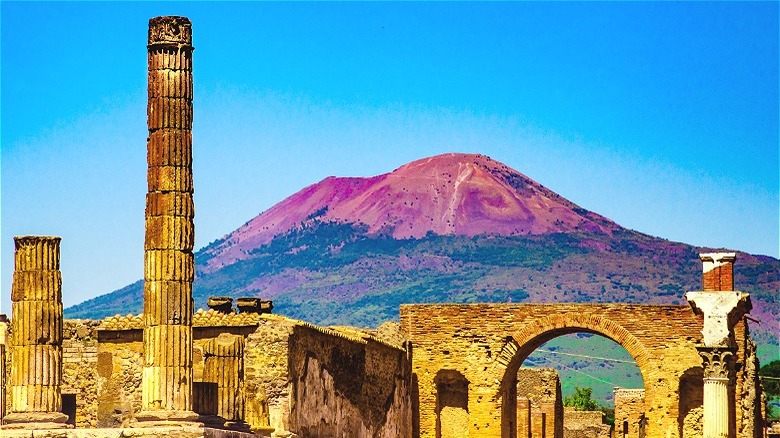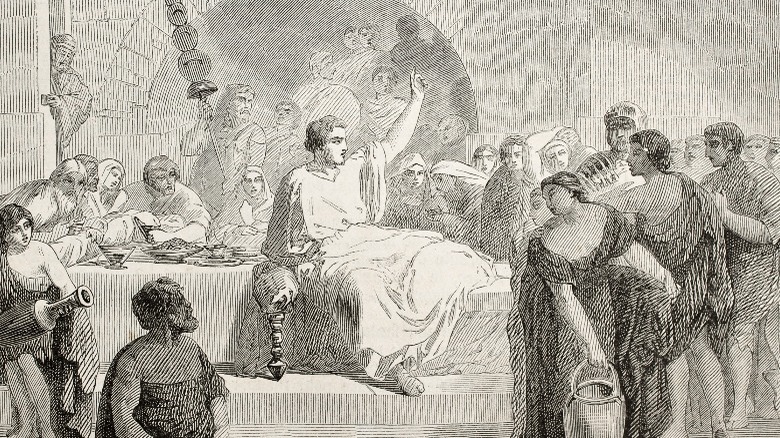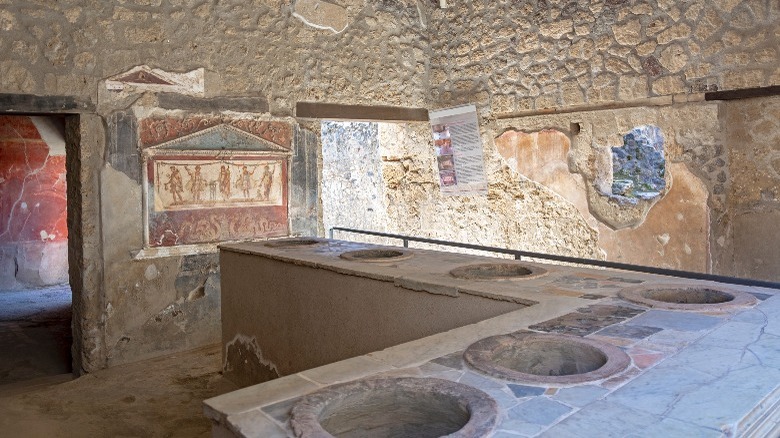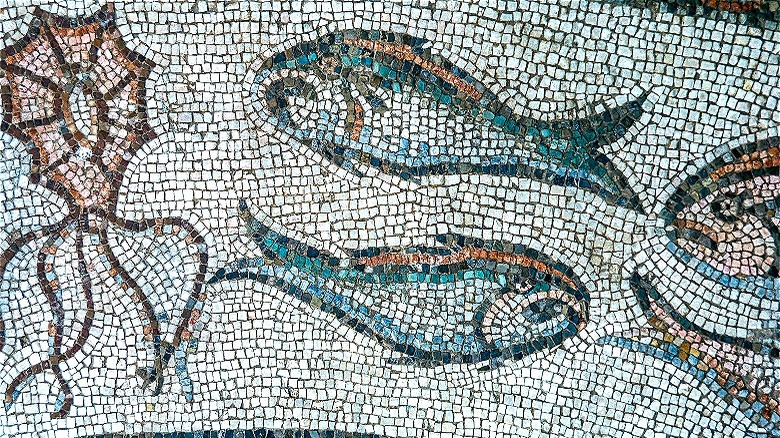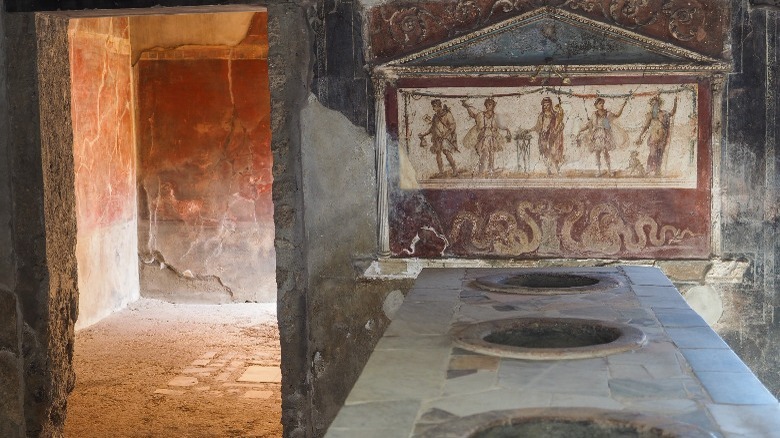The Fast Food Restaurant Discovered In Ancient Pompeii
In the last few decades, fast food has become a staple of modern society, particularly in the United States. According to The Barbeque Lab, most Americans eat fast food one to three times a week. Part of this high consumption may be due to the fact that in many places, you have easy access to it. Whether it be the McDonald's on the corner, or the Domino's around the block, satisfying your fast food craving is generally pretty easy.
But what if we were to tell you that the concept of food on the go isn't some sort of new phenomenon, and that it had been around for thousands of years? It's an interesting thought to picture a fast food joint set up in the middle of an ancient city, but apparently that was actually a thing. A recent discovery in the ruins of the ancient city of Pompeii has shed some light on the fact that the idea of "fast food" is not some new-fangled notion.
What happened to Pompeii?
Pompeii was a thriving city of the ancient Roman Empire, located near modern day Naples, Italy, just miles from Mount Vesuvius. According to History, this town had managed to become a hot spot for tourists and the Roman elite. Lots of lovely houses and villas were surrounded by shops, taverns, and bathhouses. It was also home to a 20,000-seat amphitheater for gladiatorial games and other contests. This flourishing metropolis was the place to be until A.D. 79, when tragedy struck.
In either August or October of that year (scientists are not sure of the exact date), nearby Mount Vesuvius erupted (per History). Ash and volcanic gas shot into the sky and reportedly could be seen from hundreds of miles away. With Pompeii and other smaller towns like Herculaneum being located in the shadow of this massive volcano, they sustained the brunt of the impact from this eruption. Within 24 hours, the once-vibrant town was buried underneath millions of tons of volcanic ash, and an estimated 2,000 people were dead. The city lay concealed for over 1,000 years, until it was rediscovered in 1748.
Ancient dining culture
Before its untimely demise, we know that Pompeii was by all accounts a pretty great place to be. Though it was a place that some of the more "distinguished" folks of Roman society liked to visit, that didn't mean there weren't your average citizens in the city, too. In fact, the lower-class residents and slaves were an integral part of Pompeii's success.
When it comes to the dining culture in this ancient city, one might assume that dining out options would be reserved mostly for those in the upper echelon of society, including whatever might have been passing as "fast food." In fact, the opposite was true. According to My Modern Met, the households of the rich generally had massive kitchens and personal chefs at their disposal, so they had no real reason to eat out. This meant that grabbing meals on the go was actually reserved for those of lower status.
Thermopolium Discovered 2019
While the eruption of Mount Vesuvius was devastating in many ways, one positive result (for future historians, anyway) was to keep Pompeii in pristine condition for over 1,000 years. When the site was unearthed during the 18th century, they discovered buildings and household goods still completely intact. They also found the perfectly preserved skeletons of the people who perished there, almost frozen in time. Archaeologists have been excavating the site ever since, and continue to make discoveries even today.
In 2019 a fascinating establishment was discovered (per Artnet). Researchers uncovered an essentially intact structure called a thermopolium, which (per WordSense) is essentially the fast food joint of ancient times. Though there have been around 80 other similar locations that have been found over the years, this one is unique due to the nearly perfect condition in which it was found. Additionally, this particular thermopolium has some absolutely stunning frescos and artwork that can still be seen clearly on its walls today.
Menu Items of Ancient Pompeii
What kind of fast food was served in the bustling cities of ancient Rome? Generally speaking, the Romans appeared to eat a fairly balanced diet. Their everyday choices included fowl, red meat, and fish, along with grains like wheat and oats, as well as fruits like apples, grapes, and pomegranates (per Modern Met.) When it came to drinks, the Romans didn't drink much water, but instead consumed a drink called posca (per Quartz, it was a blend of vinegar, water, and perhaps other flavorings), and of course wine. These preferences also carried over into the fast food establishments, though there were also some unique additions.
When excavating this particular thermopolium, archaeologists discovered many clues as to what kinds of foods were served there. According to Artnet, the art that adorned the walls of this structure depicted multiple animals, including roosters and other fowl. The bones of ducks, pigs, goats, and fish discovered there as well. Other items that were popular choices at establishments such as this one are believed to be meat or seafood stews, baked cheese, salty fish, and spicy wines.
Grand Reopening Thousands of Years Later
After lying dormant for thousands of years, this ancient restaurant is essentially getting new life following its discovery. The area has now been fully excavated, with multiple samples being sent away for further analysis (per Ars Technica). Incredibly, samples of food and other important materials remained intact enough to undergo more lab work, in the hopes they will reveal even more about ancient Roman life.
The location of this particular snack bar lends credence to the theory that it may have been a popular spot. It was located in a small public square, complete with a water tower and close to the ruins of some once elaborate houses. While this former fast food establishment isn't going to be serving food anytime soon, it did open to visitors in the summer of 2021, according to People.Tourists can now see this ancient diner up close for themselves, and explore the other incredible aspects of the city of Pompeii.
